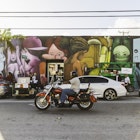Chicago is the US's third-largest city, but its efficient public transportation makes it easy to explore, which is a huge boon for travelers. This means that Chicago's top sights and experiences are all within reach – you could be relaxing by the metallic "Bean" in Millennium Park, going to a baseball game at Wrigley Field, or enjoying a performance at a storied music venue such as Buddy Guy's Legends, all while using the Ventra, the city's convenient travel pass.
The L – a system of elevated rail and subway trains – is the main way to get around the Windy City, but buses are also useful for navigating downtown and the suburbs. Here are the best ways to travel around Chicago.

Take the L train for easy transfers around town
The L – short for "elevated" – is fast, frequent and will get you to most sights and neighborhoods in Chicago. Trains run to most parts of town, and two of the eight color-coded lines – the Blue Line to O'Hare airport and the Red Line – operate 24 hours a day. Other lines run from roughly 4am to 1am daily, with trains departing every 10 minutes or so.
Trains mostly run on elevated tracks in the suburbs, dropping underground in the downtown area known as the Loop. The standard fare is $2.50 (except for services from O'Hare airport, where you'll pay about $5). Transfers within 2 hours are free (up to two additional rides are permitted). Pay for rides using a Ventra card, which can be purchased at train stations and drugstores.
Metra trains provide good connections to the suburbs
Supplementing the L, Metra commuter trains operate 12 routes serving the Chicago suburbs from four terminals around the Loop – at LaSalle Street Station, Millennium Station, Union Station and Richard B Ogilvie Transportation Center. Some Metra train lines run daily, while others operate only during weekday rush hours. Buy tickets from agents or machines at major stations.
Buses cover the gaps in Chicago
Chicago's city buses cover areas that the L trains miss, and many routes follow straight lines along major roads, making it easy to navigate. Most buses run from early morning until 10pm; some continue later, and some don't run on weekends. The standard fare is $2.25, and transfers within 2 hours are free (for up to two additional rides). You can use a Ventra card or pay the driver with exact change. Buses are particularly useful for reaching Hyde Park, Lincoln Park Zoo, and the cultural institutions of the Museum Campus (including the Art Institute of Chicago).
Get a Ventra for savings for all-day travel
The Ventra card is Chicago's rechargeable public transportation pass. There's a one-time $5 fee for the card, but this gets refunded once the card is registered. Using a Ventra card knocks around $0.75 off the cost of each bus and train ride. Ventra cards can be purchased at train stations and drugstores. Unlimited ride passes are a handy option and cost $5 for one day, $15 for three days, or $20 for seven days.
Plan your routes with Chicago's trackers and apps
For maps and route planning, check out the Chicago Transit Authority's website. The CTA Train Tracker and CTA Bus Tracker offer up-to-the-minute arrival info. Navigation apps such as Google Maps and CityMapper are also helpful. You can also download the Ventra app , which includes a trip planning tool.

Rent a bike to explore Chicago on two wheels
With more than 300 miles of bikeways, Chicago is on its way to becoming one of the best large cities in the United States for cycling. Two hundred miles of on-street protected, buffered, and shared bike lanes have been installed in recent years, with more in the works. A favorite bikeway in Chicago is the 18.5-mile Lakefront Trail, which runs along Lake Michigan, past the city's picture-perfect beaches and harbors. Riders can take bikes free of charge onto L trains, except during rush hour (7am to 9am, and 4pm to 6pm, Monday to Friday). Most buses are equipped with a bike rack at the front that can accommodate two bikes at a time.
You don't have to worry about taking your bike on the L or the bus with the popular bike-share service Divvy – there are some 600 stations around Chicago and neighboring suburbs. A $16.50 day pass allows unlimited rides of up to three hours for a 24-hour period, or opt for a single-ride pass. Purchase passes at station kiosks or via the Divvy app. Note that rates rise fast if you don't dock your bike in the allotted time. The Divvy app makes life much easier for finding docks, checking availability, and paying.
Bike rentals for longer rides start at around $8 per hour (with accoutrements such as helmets and locks). Try Bike & Roll with locations near Millennium Park and Navy Pier, or Bobby's Bike Hike, with discounts on offer if you book online.
Boats offer handy transfers along the lakeshore
Water taxis are a fun alternative to walking or taking the bus. Boats travel along the Chicago River and the lakefront and offer a different way to reach the Museum Campus.
Shoreline Water Taxi connects some of the major tourist sights operating several different lines from April to October. The Lake Route transports you from Navy Pier to the South Loop's Shedd Aquarium; the River Taxi connects Polk Bros Park (just west of Navy Pier) to Willis Tower (via the Adams Street Bridge's southeast side).
Prices depend on the day of travel, but a one-way adult ticket will cost $10–21 (children pay half price). Weekends are peak travel times. There's also a Commuter Taxi that runs from the Michigan Avenue Bridge (northeast side, near the Tribune Tower) to Willis Tower/Union Station.
Chicago is not great for car users
Driving in Chicago is no fun. Traffic snarls not only during the morning and afternoon rush hours but also just about every hour in between. Especially for short trips in town, use public transportation rather than your automobile to spare yourself the headache.
If you decide to rent a car for day trips or visits to the suburbs, you can find all the usual major car rental agencies in Chicago. Rates fluctuate wildly; in general, it's more expensive to rent at the airport than downtown. You typically need to be at least 25 years old and have a valid driver's license and a major credit card to rent a car.
The car-share service Zipcar is popular in Chicago. The hourly rate for using a vehicle starts at $11, or $83 per day, which includes gas, insurance and handy parking spaces around town. You need to become a member first, with a monthly/annual fee, plus an application fee.

Taxis are easy to find, but ride-hailing services offer savings
Licensed taxis are plentiful in the Loop, and in the areas running north to Andersonville and northwest to Wicker Park and Bucktown. Hail them in the street with a wave of the hand. Fares are measured by the meter and start at $3.25 when you get into the cab, then it's $2.25 per mile.
The first extra passenger costs $1; additional passengers after that are $0.50 apiece. And you should add 10% to 15% for a tip. All of the major Chicago cab companies accept credit cards; reliable operators include Checker Taxi and Flash Cab.
The ride-hailing companies Uber, Lyft, and Via are also popular in Chicago; these can be a bit cheaper than taxis.
Accessible transportation in Chicago
Most museums and major sights in Chicago are wheelchair accessible, as are most large hotels and restaurants. All city buses can accommodate wheelchairs, but about one-third of L stations are not accessible. Easy Access Chicago is a free resource that lists museums, tours, restaurants, and accommodations and provides mobility, vision, and hearing accessibility information for each place.
The Mayor's Office for People with Disabilities can answer questions about the availability of services in the city. For more information, download Lonely Planet's free Accessible Travel Resources.













